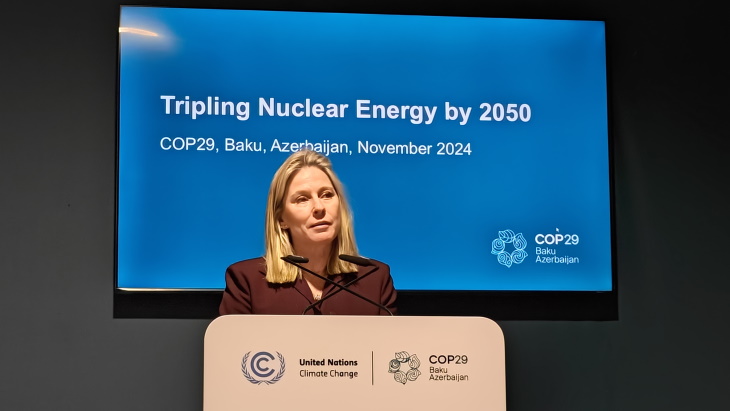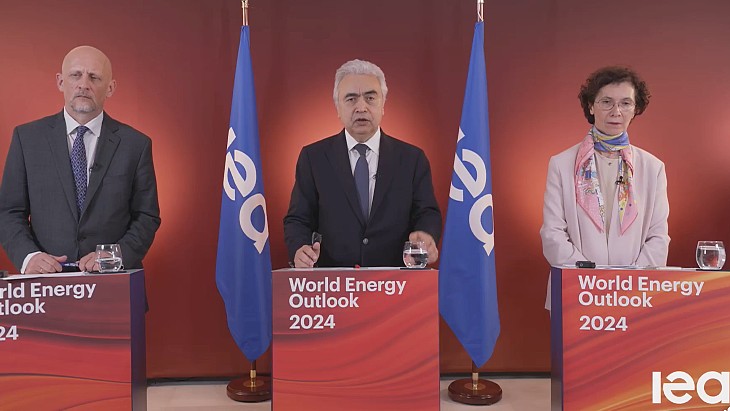NEI's Maria Korsnick charts 'sea change' for nuclear
.jpg)
Korsnick presented the US nuclear industry's policy priorities, provided perspective on the future of nuclear, and discussed how the industry is critical to advancing climate goals, workforce, energy markets, and global partnerships.
The climate crisis is no longer a "vague, theoretical discussion", and leaders in the USA and elsewhere have now recognised that the response to that climate crisis is intrinsically tied to the electrical grid, the economy and energy security, she said, with strong corporate commitments and policy goals now in place to reduce carbon emissions using every clean energy source at our disposal. But achieving "true, deep decarbonisation" will require more than "tinkering round the edges".
Over the past year, she said, she had observed a "sea change" in perceptions of nuclear energy, which has steadily gained recognition as a tool to drive down emissions with bipartisan political support at all levels of the US political system. Under the Bipartisan Infrastructure Law, USD6 billion has been allocated to support the continued operation of existing US nuclear power plants under the threat of closure, USD2.5 billion towards advanced reactor demonstrations before the end of the current decade, and a large-scale demonstration of carbon-free hydrogen production using nuclear energy is called for, she noted.
Support is also being harnessed at the state level. "Ten years ago, we would have been lucky to see even a dozen pro-nuclear bills moving through state legislatures," she said. "In recent years we've seen ten times more action in the states and more than 100 bills supporting nuclear."
This momentum at the federal and state level is a testament to the value of the existing fleet and progress on next-generation technology. Next-generation reactors will pair "perfectly" with sources like wind and solar, but recent studies have shown that while nuclear has the potential to provide more than 40% of US electricity by 2050, a system that relies on wind and solar to "do the heavy lifting" would be prohibitively expensive.
"The upshot is clear: nuclear is the critical component that actually makes complete decarbonisation affordable while keeping our grid reliable," she said.
Versatility and jobs
The versatility of new reactor designs open new possibilities for carbon-free energy service at any scale, Korsnick said, from advanced large reactor designs being considered by countries such as Poland to replace coal-fired power stations, to microreactors which are a "great fit" for isolated regions such as Alaska and northern Canada.
The US nuclear industry currently employs some 100,000 people directly, with the supply chain indirectly employing four times that, she said. "When we build the reactors of tomorrow, we're going to activate even more segments of the American workforce," she added. Advanced nuclear reactors will be "local economic engines" providing quality, secure jobs, while siting small modular reactors to replace retiring coal plants will enable existing transmission infrastructure to be used, while an estimated 75% of the current coal plant workforce is expected to be able to transition into jobs at the nuclear plant.
All hands on deck
Nuclear energy's potential for decarbonization goes beyond the electric grid, and this has brought new potential customers to nuclear as the oil and gas and chemical manufacturing industries in the US and elsewhere look to nuclear to decarbonise their supply chains, she said. Looking further ahead, nuclear will play a part in hydrogen production for the manufacturing and transportation sectors, while new technologies will provide high-temperature heat to decarbonise heavy industry.
There is an "unprecedented opportunity" for the USA to rebuild its leverage in the global supply chain, she said. Events in Ukraine have underscored the link between energy security and national security, and the NEI is working alongside US policymakers to establish a secure and reliable uranium fuel supply that will eliminate the need for Russian imports, she said. While such a decision is simple to make, "it won't be easy to execute - and it can't be done overnight," she said.
"Keeping plants online will require an all-hands-on-deck effort: from fuel suppliers, utilities, investors, and others … We will also need federal support to re-establish U.S. leadership in fuel conversion and enrichment capabilities."
Meeting the challenge
"At this point, our challenge isn't a lack of demand - it's being able to build fast enough to meet the demand before us," Korsnick said, citing an NEI poll of chief nuclear officers at US facilities who together are expecting to add 90 GW of nuclear power to the US grid, with most of that coming online by 2050 - which translates to "about 300 new small modular reactors in the next 25 years".
This will bring challenges for US regulators - who will need a more efficient process to review and approve licenses for new designs - and financing. "The overall opportunity is massive. According to one estimate, revenues for US companies alone could be worth up to USD1.9 trillion in exports over the next 30 years. That's value we can't afford to miss out on," she said.
"If we don't commit to the next generation of nuclear now, our hesitation will cost our electric grid, our economy, and our environment. The train is leaving the station.
"It's time to go all-in on nuclear energy."

_99697.jpg)







_88592.jpg)
_66488.jpg)

